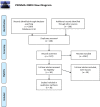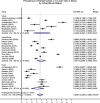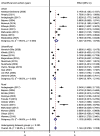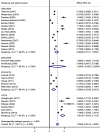Prevalence of dental caries in the permanent dentition amongst 12-year-olds in Africa: a systematic review and meta-analysis
- PMID: 36280818
- PMCID: PMC9594869
- DOI: 10.1186/s12903-022-02489-4
Prevalence of dental caries in the permanent dentition amongst 12-year-olds in Africa: a systematic review and meta-analysis
Abstract
Background: Dental caries (DC) is highly prevalent condition affecting mostly young children. There has been no systematic review done on the prevalence of DC amongst 12-year -olds in Africa. Although some African countries have reported a decrease in DC prevalence, others have shown an increase and it is essential to measure current trends in order to identify strategies and programmes that could assist in reducing DC in Africa. The aim of this systematic review was to determine the prevalence of DC (condition) amongst the permanent dentition of 12-year-old children (population) in Africa (context).
Methods: A systematic review and meta-analysis was performed. Peer reviewed cross-sectional articles from January 2000 until December 2021 was searched and this included the following databases: Pubmed (Medline); SCOPUS; CINAHL (via EBSCOhost); Academic Search Complete (via EBSCOhost); Dentistry and Oral Sciences Sources (via EBSCOhost); and Science Direct. The search was last updated on the 10th January 2022. Joanna Briggs Institute critical appraisal tools were used to assess risk of bias. Prevalence figures were stratified by Urban/Rural status, country and time using a random-effects model. All studies performed on children 12-year-olds on the African continent were included. The prevalence of DC and the DMFT scores were the primary and secondary outcome measures, respectively. Only articles consisting of 12-year-old children who reside in Africa were included in this study. The systematic review was registered with Prospero CRD42021293666.
Results: 18,080 participants were included in this review. A total of thirty studies were included in the review. The pooled effect size of dental caries severity was 1.09 (CI 0.91-1.27) and the overall prevalence was 36% (CI 29.4-41.7%). Eritrea (78%) had the highest prevalence of DC while Zambia had the lowest (11%); Eritrea also had the highest DMFT score (2.5) with Sudan having the lowest score (0.49). Urban cities had the highest DMFT score (1.32, CI 0.97-1.68), compared to rural cities (1.13, CI 0.86-1.4) and there was an increasing trend in DC prevalence over time from 28% (CI 23-34%) in 2000 to 2005 to 57% (CI 43-72%) in studies conducted after 2015. The risk of bias was very low where majority of the studies scored more than 50% in the JBI critical appraisal tool.
Conclusions: There was a wide discrepancy in the DC prevalence and scores across the different countries, settings (rural versus urban) and there was an increase in the prevalence over time. This review was self-funded.
Keywords: 12-year-old; Africa; Caries prevalence; DMFT; Rural; Urban.
© 2022. The Author(s).
Conflict of interest statement
The authors declare that the research was conducted in the absence of any commercial or financial relationships that could be construed as a potential conflict of interest.
Figures








Similar articles
-
Exploring the cost-effectiveness of child dental caries prevention programmes. Are we comparing apples and oranges?Evid Based Dent. 2020 Mar;21(1):5-7. doi: 10.1038/s41432-020-0085-7. Evid Based Dent. 2020. PMID: 32221482
-
Dental caries in children in Ireland: A systematic review.Community Dent Oral Epidemiol. 2024 Feb;52(1):24-38. doi: 10.1111/cdoe.12897. Epub 2023 Jul 29. Community Dent Oral Epidemiol. 2024. PMID: 37515429
-
Trends of dental caries in permanent teeth among 12-year-old Chinese children: evidence from five consecutive national surveys between 1995 and 2014.BMC Oral Health. 2021 Sep 23;21(1):467. doi: 10.1186/s12903-021-01814-7. BMC Oral Health. 2021. PMID: 34556097 Free PMC article.
-
Beyond the black stump: rapid reviews of health research issues affecting regional, rural and remote Australia.Med J Aust. 2020 Dec;213 Suppl 11:S3-S32.e1. doi: 10.5694/mja2.50881. Med J Aust. 2020. PMID: 33314144
-
Prevalence of early childhood caries in South Africa: a systematic review.BMC Oral Health. 2022 Feb 8;22(1):32. doi: 10.1186/s12903-021-01982-6. BMC Oral Health. 2022. PMID: 35135513 Free PMC article.
Cited by
-
Dental Caries Status of Children and Adolescents in West Africa-A Literature Review.Healthcare (Basel). 2025 Apr 22;13(9):961. doi: 10.3390/healthcare13090961. Healthcare (Basel). 2025. PMID: 40361739 Free PMC article. Review.
-
Dental caries in Rwanda: A scoping review.Health Sci Rep. 2023 May 7;6(5):e1258. doi: 10.1002/hsr2.1258. eCollection 2023 May. Health Sci Rep. 2023. PMID: 37168280 Free PMC article.
-
Evaluation of caries experience among schoolchildren in Central African Republic.Sci Rep. 2025 Mar 15;15(1):9006. doi: 10.1038/s41598-025-86341-z. Sci Rep. 2025. PMID: 40089550 Free PMC article.
-
Prevalence of dental caries and associated factors among secondary school students in Kigali, Rwanda: a cross-sectional study.BMC Oral Health. 2025 Feb 22;25(1):285. doi: 10.1186/s12903-025-05604-3. BMC Oral Health. 2025. PMID: 39987128 Free PMC article.
-
Dental caries prevalence, preventive behaviour and related factors among adolescents in Nigeria: a 10-year systematic review and meta-analysis.BMC Oral Health. 2025 Jul 10;25(1):1138. doi: 10.1186/s12903-025-06504-2. BMC Oral Health. 2025. PMID: 40634952 Free PMC article.
References
-
- Gilchrist F, Marshman Z, Deery C, Rodd HD. The impact of dental caries on children and young people: What they have to say? Int J Paediatr Dent. 2015;25(5):327–338. - PubMed
-
- Karki S, Päkkilä J, Laitala ML, Humagain M, Anttonen V. Influence of dental caries on oral health-related quality of life, school absenteeism and school performance among Nepalese schoolchildren. Community Dent Oral Epidemiol. 2019;47(6):461–469. - PubMed
-
- Quadros LN, Rebelo MAB, de Queiroz AC, Pereira JV, Vettore MV, Rebelo Vieira JM. Clinical consequences of untreated dental caries and school performance in low-income adolescents. Int J Paediatr Dent. 2021;31(5):619–626. - PubMed
-
- Barasuol JC, Soares JP, Castro RG, Giacomin A, Goncalves BM, Klein D, et al. Untreated dental caries is associated with reports of verbal bullying in children 8–10 years old. Caries Res. 2017;51(5):482–488. - PubMed
Publication types
MeSH terms
LinkOut - more resources
Full Text Sources
Medical

